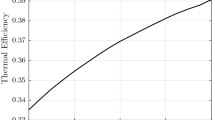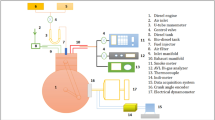Abstract
Currently, variable compression ratio engines are not used, presumably due to the complexity of the design. Currently, various engines are being developed that differ in design, kinematics, load control and compression ratio changes. The article presents the results of calculating the efficiency and fuel consumption for a crankshaft with a rotation speed of 2000 and 4000 rpm with a compression ratio of 8.6 and a rotation speed of 4000 rpm with a compression ratio of 13 and provides combustion characteristics m = 3 and 1. It is shown that these characteristics at higher speeds they approach the indicators at lower speeds with an increase in the compression ratio. The engine parameters were calculated for various modes based on Wiebe theory. Based on the calculations, the efficiency and fuel consumption are determined for the corresponding modes and the nature of the engine operation. It has been found that with an increase in the crankshaft rotation speed, the cycle efficiency will decrease by almost half and fuel consumption will increase accordingly; with an increase in the compression ratio, the efficiency is restored and fuel consumption decreases accordingly.
Similar content being viewed by others

Avoid common mistakes on your manuscript.
INTRODUCTION
Thanks to flexible control of the compression ratio, it is possible to influence the parameters of physical processes in the engine that affect fuel consumption and the emission of toxic components: pressure and temperature at the end of the compression stroke; maximum combustion pressure and temperature; degree of expansion and indicator efficiency; combustion chamber volume; exhaust gas temperature.
Despite the fact that adjusting the compression ratio is a difficult task, known two-shaft designs can be used without significant complications [1–4]. Work [5] showed a decrease in engine efficiency with increasing crankshaft rotation speed, which can be corrected by compensating the compression ratio. The article [6] pointed out the prospects of using twin-shaft engines [1–5] with an adjustable compression ratio. Here, according to the data in article [6], the results of calculating the efficiency and fuel consumption for speeds of 2000 and 4000 rpm with a compression ratio of 8.6 and a speed of 4000 rpm with a compression ratio of 13 and combustion characteristics m = 3 and 1 are presented. The indicated characteristics at higher speeds are shown to approach characteristics at lower speeds with increasing compression ratio. Previously [5] engine parameters were calculated under various modes based on Wiebe theory. Using the data from the above calculations, the efficiency and fuel consumption are determined for the corresponding modes and nature of engine operation.
MATHEMATICAL MODEL
The calculation is made under the following conditions:
Specific volume of working fluid
where λ is the ratio of the crank radius.
Proportion of fuel burned at the site \(i - \left( {i - 1} \right)\)
Pressure of the working fluid in the cylinder during the combustion process
where k is the heat capacity factor; qz is the total heat of combustion used.
Ignition timing is 24°, compression ratios are 8.6 and 13, rotation speed is 2000 and 4000 rpm, combustion character indicators m = 1 and 3. Flame front inclination angle φr = 46° and 92°.
Table 1 shows the data of this calculation. Based on these data, the corresponding efficiency factors and fuel consumption were determined.
NUMERICAL MODEL
Figure 1 shows a diagram for determining the operation of the cycle. Based on the points on the graph, the state of the cycle is determined, from which the efficiency is calculated.
The cycle work is composed of the sum of the combustion work during compression
The cycle work is composed of the sum of the combustion work during expansion
The work of the cycle is made up of the sum of the work of pure compression
The work of the cycle is composed of the sum of the work of pure expansion
where \({{p}_{b}} = {{\left( {\frac{{{{{v}}_{z}}}}{{{{{v}}_{b}}}}} \right)}^{{{{n}_{2}}}}}\), \({{p}_{z}} = {{\left( {\frac{{{{{\text{v}}}_{z}}}}{{{{{\text{v}}}_{a}}}}} \right)}^{{{{n}_{2}}}}}{{p}_{z}}\).
Complete cycle work
Efficiency determined by the formula
where H is the lower calorific value of the fuel (H = 10500 kcal/kg); (1 + γ) is the coefficient of residual gases, (1 + γ) = 1.088; α is the excess air coefficient (α = 0.85); \(L_{0}^{'}\) is the theoretically required amount of air for complete combustion of 1 kg of fuel (\(L_{0}^{'}\) = 14.8 kg g).
Indicated specific fuel consumption \(~g = \frac{{632}}{{{{{{\eta }}}_{i}}Hu}}\).
RESULTS
I. Consider the case \({{\varepsilon }} = 8.6\); m = 3; φr = 46°
According to formula (6)
Indicated specific fuel consumption
where g/(h.p h)—grams per horsepower hour.
II. In case of \({{\varepsilon }} = 8.6;\,\,m = 1;~\,\,{{{{\varphi }}}_{r}} = 46^\circ \)
According to formula (6)
Indicated specific fuel consumption
III. In case of case \({{\varepsilon }} = 8.6\); m = 3; φr = 92°
According to formula (6)
IV. In case of \({{\varepsilon }} = 8.6\); m = 1; φr = 92°
According to formula (6)
V. In case of \({{\varepsilon }} = 13\); m = 3; φr = 64°
According to formula (6)
VI. In case of \({{\varepsilon }} = 13\); m = 1; φr = 64°
According to formula (6)
CONCLUSIONS
With an increase in crankshaft rotation speed from 2000 to 4000 rpm, the efficiency of the cycle will decrease by almost half and fuel consumption will increase accordingly. By increasing the compression ratio from 8.6 to 13 at a speed of 4000 rpm, the efficiency is restored and fuel consumption decreases accordingly.
As the crankshaft rotation speed increases, the pressure in the cylinder drops and the efficiency decreases. In order to restore pressure and, accordingly, efficiency, compression ratio control can be applied, which must be provided for in the engine design.
REFERENCES
Moteki, K., Fujimoto, H., and Aoyata, S., Variable compression ratio mechanism of reprocating internal combustion engine, US Patent 6505581, 2002.
Cleevs, J.M., Variable compression ratio system for opposed piston and other methods of manufacture and use, US Patent 9206749, 2013.
Turner, J.W.G., Opposed piston internal combustion engine with variable timing, GB Patent 2428450, 2007.
Vibe, I.I., Novoe o rabochem tsykle dvyhatelya (New Information about the Engine Operating Cycle), Moscow: Mashgiz, 1962.
Klomp, E.D. and Rask, R.B., Variable compression ratio control system for an internal combustion engine, US Patent 6450136, 2002.
Agalarov, J., Nasibova, A., and Nuriyev, B., Internal combustion engine with opposed pistons, US Patent 6039011, 2000.
Dyachenko, V.G., Teoriya dvigatelei vnutrennego sgoraniya (Theory of Internal Combustion Engines), Kharkov: Kharkivsk. Nats. Avtomobil’no-Dorozhnyi Univ., 2009.
Pshikhorov, V.Kh., Dorukh, I.G., and Beresnev, A.L., Engine ignition system, RF Patent 2446309, 2010.
Beresnev, M.A., L-variation method for controlling internal combustion engines when operating on binary fuel, Izv. Yuzhnogo Fed. Univ., Tekh. Nauki, 2012, no. 3, pp. 251–256. https://elibrary.ru/ovyzcn.
Vagner, V.A., Application of alternative fuels in internal combustion engines, Vest. Altaisk. Gos. Tekh. Univ. I.I. Polzunova, 2000, no. 2, pp. 77–86. https://elibrary.ru/xyntxn.
Köse, H. and Ciniviz, M., An experimental investigation of effect on diesel engine performance and exhaust emissions of addition at dual fuel mode of hydrogen, Fuel Process. Technol., 2013, vol. 114, pp. 26–34. https://doi.org/10.1016/j.fuproc.2013.03.023
Christodoulou, F. and Megaritis, A., Experimental investigation of the effects of simultaneous hydrogen and nitrogen addition on the emissions and combustion of a diesel engine, Int. J. Hydrogen Energy, 2014, vol. 39, no. 6, pp. 2692–2702. https://doi.org/10.1016/j.ijhydene.2013.11.124
Sharoglazov, B.A., Farafontov., M.F., and Klementyev, V.V., Internal Combustion Engines: Theory, Modeling and Calculation of Processes, Chelyabinsk: Yuzhno-Ural. Gos. Univ., 2004.
Baumgarten, C., Mixture Formation in Internal Combustion Engines, Heat and Mass Transfer, Berlin: Springer, 2006. https://doi.org/10.1007/3-540-30836-9
Saha, K. and Li, X., Assessment of cavitation models for flows in diesel injectors with single- and two-fluid approaches, J. Eng. Gas Turbines Power, 2016, vol. 138, p. 11504. https://doi.org/10.1115/1.4031224
Funding
This research was supported by National Academy of Sciences of Azerbaijan (NASA), Institute of Mechanics and Mathematics (IMM), Baku, Azerbaijan and Patent: US 6039011. Date: Appl. March 4, 1998, Publ. March 21, 2000.
Author information
Authors and Affiliations
Corresponding author
Ethics declarations
The authors of this work declare that they have no conflicts of interest.
Additional information
Publisher’s Note.
Pleiades Publishing remains neutral with regard to jurisdictional claims in published maps and institutional affiliations.
About this article
Cite this article
Agalarov, J., Hasanova, T. & Imamalieva, J. Influence of Compression Ratio on Pressure in the Cylinder of Internal Combustion Engine. J. Mach. Manuf. Reliab. 53, 390–396 (2024). https://doi.org/10.1134/S1052618824700298
Received:
Revised:
Accepted:
Published:
Issue Date:
DOI: https://doi.org/10.1134/S1052618824700298




